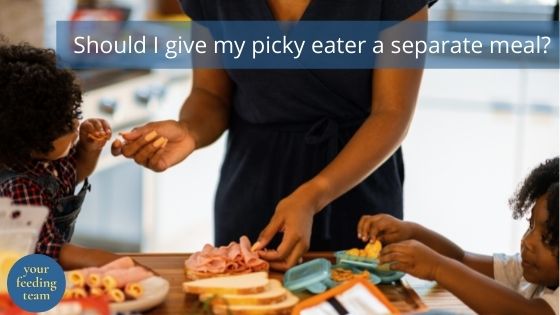Making kids eat or try foods they don’t feel comfortable eating backfires in a major way. But you know that, right? Because most parents struggling with picky eating will feel like they’ve tried EVERYTHING to get their child to eat. Our guess is that the response to this ‘encouragement’ has been… shall we say… not great?
If you’re not going to try to make your child eat the foods you’d like them to be eating, where does this leave you? Making a separate meal may seem like the logical conclusion. After all, if you’re not going to persuade them into enjoying the meal you’re eating, it seems obvious that you have to make them something else. We are not fans of the ‘eat it or go hungry’ approach here at Your Feeding Team.
However, separate meals are not the way.
Making a separate meal for one child can reinforce their sense that they can’t cope with other family foods. When we give a child one plate of food and tuck into something different ourselves, we are basically saying: “These are my foods, those are your foods”. The total opposite of the message we want to convey. A separate meal closes doors because if all the foods were part of one big communal meal, there is more opportunity for children to branch out when they are ready. More on how this works later.
Modelling (i.e., what your kids see you doing) is a powerful influence over how children respond to food. If you are modelling something they can’t do, it loses some of its meaning. So when you eat your curry and rice as they tuck into a mac ‘n’ cheese, they are less likely to be categorizing the curry or rice as foods they may get curious about one day. You’ve inadvertently told them it’s not for them.
It can cause issues with siblings. If you have a child who generally enjoys a pretty varied diet, they may take issue with not getting the separate meal you’ve made for their brother or sister. This can lead to negativity and arguments… things researchers know make avoidant (picky) eating worse.
It’s a major hassle. Do you really want to cook multiple meals? Time is short and family life can be pretty hectic. Anything that makes life easier has to be a win.
Here’s what to do instead
So we’ve said we don’t believe in (ever) making children eat non-accepted foods or go without. We’ve said that separate meals may make things worse and we don’t recommend them. You may be thinking that this leaves you without any options. Not so.
We advocate family style meals. This means that everyone starts off with an empty plate (including you!) and all the foods are available to everyone. If you plan in a couple of your child’s accepted foods at every meal, you can relax in the knowledge that there will be something there they can handle. No pressure, no drama… the foods are there and – instead of trying to get them to eat them – you just carry on with a relaxed family meal.
The way children learn to eat a wider diet is through positive mealtime experiences and autonomy. This approach is called ‘responsive feeding’. The autonomy (feeling free to make their own choices) comes from being able to help themselves (from the foods you’ve provided). The positive atmosphere comes from you focusing on spending nice time with them at mealtimes as opposed to working on getting food down them.
All of this lays the foundations for children to begin to feel safe exploring new foods ON THEIR OWN TERMS. The shouty capitals are to highlight that you don’t need to get kids to eat. Most will get there if you create the right environment. It takes time and it takes work because undoing the habit of persuading / rewarding / praising / bribing kids to eat isn’t something that happens overnight.
For more details on how to adopt a responsive feeding approach (and find workable alternatives to a separate meal for your child) membership of Your Feeding Team is a cost-effective answer, run by feeding professionals for parents. Join here.
